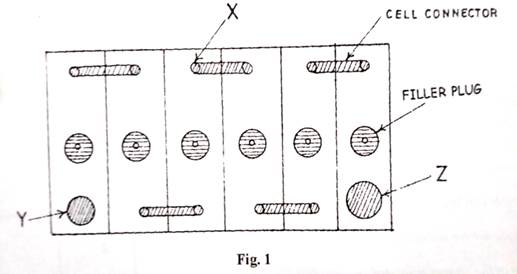Question 1
Fig. 1 is the diagram of a type battery used in a motor vehicle. Use it to answer questions 1(a) to 1(d).

(a) (i) Identify the type of battery represented in Fig. 1.
(ii) State one reason for your answer in 1(a) (i).
(b) (i) Identify the letter representing the positive terminal of the battery.
(ii) Give one reason for your answer in 1(b) (i).
(c) State one:
(i) function of the filler plug in the battery;
(ii) physical feature of the filler plug.
(d) State:
(i) the type of connection between the cells;
(ii) one effect of a broken cell connector in the battery.
(e) If the electrolyte level of a battery is found to be low, state:
(i) one possible effect that would be noticed on the battery;
(ii) two possible causes of the low electrolyte level.
(f) Describe, in four steps, the process of topping up electrolyte in a lead-acid battery.
(g) Name three faults in a battery, other than low electrolyte level, that may affect
the operation of a motor vehicle.
(h) State two routine maintenance practices that should be carried out on a motor
vehicle battery.
Observation
The expected responses were:
(a)(i) Conventional lead-acid battery.
(ii) Reason for answer in 1(a)(i)
- Presence of filler plugs to each cell
- Visible cell connectors
(b)(i) Z
(ii) Reason for answer in 1(b)(i)
It is the bigger terminal
(c)(i) Function of filler plug in the battery
- It prevents electrolyte spillage.
- It prevents dirt from entering the battery.
- It provides an opening for topping up electrolyte.
(ii) Physical feature of filler cap
- Presence of vent
- Presence of thread
(d)(i) Series connection
(ii) Effect of a broken cell connector in the battery
- Open circuit
- Battery stops functioning
- Battery produces no voltage
- Low battery capacity
(e)(i) Possible effects of low electrolyte noticeable in battery
- Damaged cell
- Low output current/voltage
- Exposed cells/plates
(ii) Possible causes of low electrolyte level
- Overcharging
- Spillage
- Cracked/broken casing
- Excessive gassing
(f)(i) Steps involved in topping up electrolyte in a lead-acid battery
- Open the filler cap/plug
- Fetch electrolyte/distilled water and top up to required level
- Lock the filler cap/plug
- Clean top of battery with duster
(g) Faults in a battery that may affect the operation of a motor vehicle
- Short circuit
- Damaged cells/plate
- Broken/loose terminals
- Open circuit
- Abnormal specific gravity of electrolyte
- Polarization
- Broken cell connector
(h) Routine maintenance practices for a motor vehicle battery
- Check and clean battery terminals if necessary
- Check and top up electrolyte level if necessary
- Check and tighten battery clamps/secure battery
- Smear battery post with light grease
- Clean battery top
- Check and tighten battery terminals
Question 1 required candidates to show familiarity with features and treatment of a lead-acid battery. The Chief Examiner reported that majority of the candidates who attempted question 1 were only able to respond to the few recall tasks but largely unable make the appropriate deductions.
